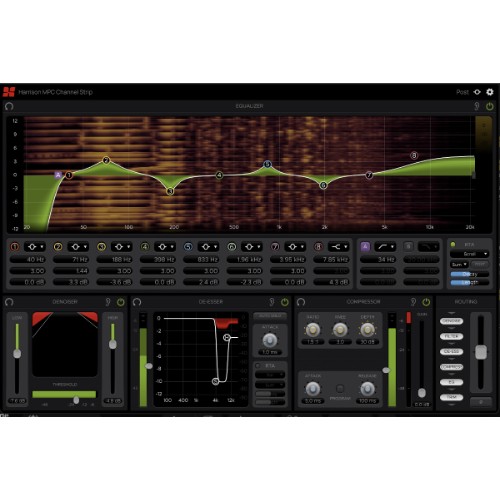
Harrison MPC Channel Strip
Der MPC Channel ist eine All-in-One-Signalverarbeitungssuite für das Mischen und Bearbeiten von Audio in der Postproduktion von Filmen. Er ist mit sechs wichtigen Mischwerkzeugen ausgestattet, die denselben leistungsstarken DSP verwenden, der auch in der berühmten MPC (Motion Picture Console) von Harrison zum Einsatz kommt, die in High-End-Filmstudios auf der ganzen Welt verwendet wird.
Die Bearbeitungsbereiche können alle gleichzeitig in einem größenveränderbaren Fenster überwacht werden, so dass alles, was passiert, auf einen Blick zu sehen ist. Zu den weiteren nützlichen Funktionen gehören ein neu anordenbarer Signalfluss, vollständig automatisierbare Parameter und erweiterte RTA-Anzeigen. MPC Channel ist für großformatige Postproduktionssessions optimiert und ermöglicht den Einsatz von Hunderten von Instanzen, ohne die CPU-Leistung zu beeinträchtigen.
Features
-
Parametrischer 8-Band-Equalizer mit einer breiten Palette von RTA-Optionen
-
Mehrpolige Filter mit verschiedenen wählbaren Formen
-
2-Band De-Esser basierend auf dem X-Tool DSP der Harrison MPC Digitalkonsolen
-
2-Band Denoiser zur Beseitigung von unerwünschten Hintergrundgeräuschen
-
Kompressor mit einer Vielzahl von einstellbaren Parametern und einem wählbaren programmabhängigen Modus
-
Routing, Trim & Polarity-Sektion zum Umstellen der Reihenfolge des Signalflusses, zum Umschalten der Polarität und zum Anpassen der Eingangs-/Ausgangs-Trimmung

Weitere Details in englischer Sprache:
Equalizer
The MPC’s Equalizer module is a parametric 8-band EQ with an additional pair of filters and an optional RTA display. This module consists of 4 sections:
- Graph: Shows a visual representation of the EQ curves over the RTA display
- Band Control: Controls the parameters for each of the 8 bands
- Filter Control: Controls the parameters for the high and low filters
- RTA Control: Controls the RTA display
Denoiser
The Denoiser is optimized for processing speech. The cutoff frequencies of the high and low filters are preset to best accommodate the frequency range of the human voice and the envelope is set to match the rate of normal speech.
The Denoiser functions like an expander for frequencies outside the range of the human voice. The HIGH and LOW sliders control the maximum amount of Gain reduction applied to signals within each band’s respective Frequency range. The maximum Gain reduction set for each band will only be applied to signals below the Threshold. All Signal levels above the Threshold will be allowed to pass through with variable Gain reduction based on the dynamic characteristics of the signal.
De-Esser
Harrison’s renowned De-Esser algorithm is primarily used to attenuate harsh frequencies caused by sibilance in human speech.
The two circular markers on the graph display, labeled “S” and “H”, are the controls for the Ess and Hi bands (S = Ess, H = Hi). These controls can be dragged horizontally or vertically to set the Bandwidth and Depth of their respective bands. The low cutoff Frequency for the Ess band has a range of 200 Hz to 8 kHz, while the Hi band control has a range of 2 kHz to 12 kHz for taming any additional frequencies above that.
Compressor
The MPC’s Compressor module is optimized for vocal compression, but its flexible controls allow it to meet a variety of other needs as well. Its components includes:
- Ratio - with possible values from 1:1 to 100:1
- Knee - with a possible values range of 1.0 to 30.0
- Depth - with a possible values range from 0.1 ms to 100 ms
- Attack - times range from 0.1 ms to 100 ms
- Release - times range from 5 ms to 500 ms
Routing, Trim & Polarity
The order of signal flow between the six elements can be rearranged by dragging an element’s marker to its desired position along the signal chain, which flows from top to bottom. Dragging an item to another slot will swap the positions of the two items.
The Trim fader can adjust the Gain of the signal passing through it (-20 dB to +20 dB). This is also a routable item, so it can serve as an input or output Trim depending on its position in the signal chain.
The Polarity switch inverts the phase of the output waveform (flips it 180°) when selected.
RTA
The RTA is calculated using a Discrete Fourier Transform, which provides high resolution data even in lower frequency ranges. The Equalizer and De-Esser modules each have sections for controlling their RTA displays. The controls described here apply to the RTAs in both modules, unless noted otherwise.
Mac:
- macOS 11 - 13
- Apple Silicon kompatibel
Windows:
- Windows 10 oder höher
Erforderliche Registrierung:
Für die Nutzung von Harrison Consoles Produkten müssen Sie sich beim Hersteller unter www.harrisonconsoles.com sowie bei www.solidstatelogic.com und bei www.ilok.com registrieren, um Ihre Lizenz zu aktivieren.
Dieses Produkt benötigt eine Aktivierung!
Diese kann entweder auf Ihrem Computer (ohne zusätzlichen Hardware) erfolgen oder alternativ auf einem separat zu erwerbenden iLok USB-Dongle. Der iLok USB-Dongle kann an beliebigen Computern angesteckt werden, um die damit geschützte Software auf mehreren Rechnern zu benutzen. Ihre Lizenzen können über den iLok License Manager beliebig verwaltet und durch eine zusätzliche Versicherung (Zero Downtime mit TLC) vor Verlust oder Diebstahl geschützt werden.
Zur Produktaktivierung benötigern Sie eine Internetverbindung auf einem beliebigen Computer sowie einen kostenlosen User-Account auf www.ilok.com.
Bitte prüfen Sie beim Software-Hersteller, welche iLok Version mindestens benötigt wird, falls Sie einen Hardware iLok benutzen möchten!



